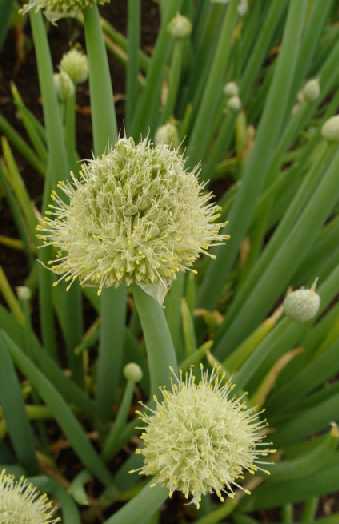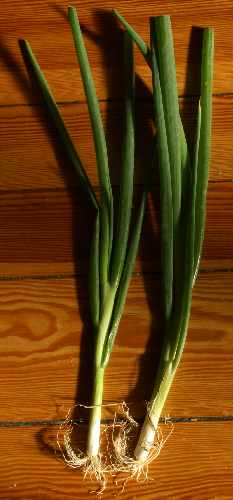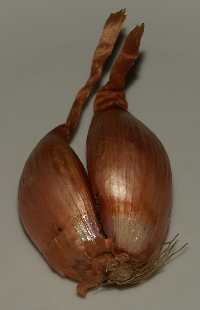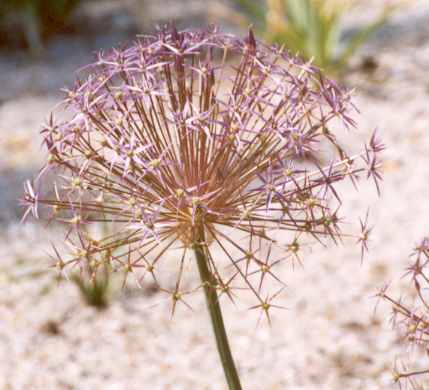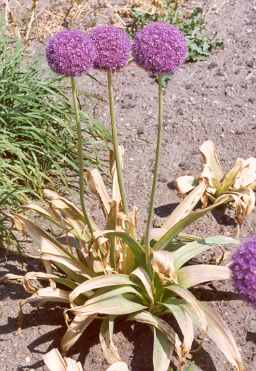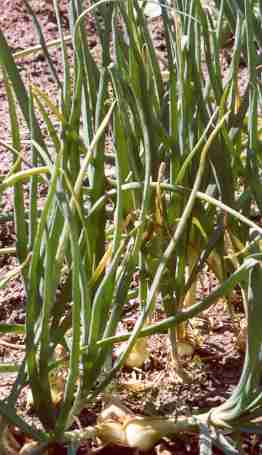
|
|
Onion plants
|
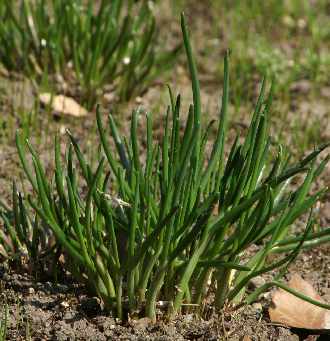
|
|
Young onion plant
|
Onion is certainly a borderline case between spices and
vegetables: While they are used chiefly for flavour in some recipes, they play rather the rôle of a vegetable in others, providing nutrients and volume.
I have, however, included onions as spices to these pages because they are an
indispensable ingredient to nearly every cuisine of the world, and it is used
for large spectrum of different dishes, where onions yield volume, texture,
flavour or pungency according to the recipe details.
Most importantly, their flavour depends on many preparation details, which makes them a versatile
tool for the cook knowing about their properties; in that, they resemble spices more than vegetables.
The recorded history of onion begins early, in the Bronze Age.
Both onions and garlic were highly popular in Ancient
Egypt. It is known that these plants were part of the diet of the workers
involved in the erection of the Great Pyramids; presumably, this also served
to prevent infectious diseases to spread in the densely populated workers’
quarters. The Old Testament mentions both onion and garlic specifically
in connection with the sojourn of the Israelites in Egypt (see also
pomegranate for a list of spices mentioned
in the Bible). Another Bronze-Age source, the Illiad of Homer,
mentions them in a culinary context (see poppy.

| |
Young onion plant
|
|
|
|
Both onion and garlic are featured prominently in
a collection of Babylonian recipes from Mesopotamia (ca. 1600), which is now
kept at the University of Yale and known as Yale Recipes
. The about
35 recipes written on three clay tablets show that onion and relatives were
characteristic flavours of ancient Babylon: Onion (Akkadian šusikillu),
leek (karšu, karašu) and
garlic (hazanu) appear in
almost every recipe, usually in mashed form to be stirred into the foods.

|
|
Portrait of Xuan Zang [玄奘] in the Vaikunta Perumal temple [வைகுண்டா பெருமள் கோயில்] in Kanchipuram (Tamil Nadu)
|
The collection also uses other spices, some of which are still named similar
in modern Semitic tongues, so that the identification appears sound:
mint (ninū),
coriander (kisibirru),
cumin (kamûnu),
and dill (šibittu).
Other spices part of the oldest documented cuisine of the world
are less easy to identify: egenguru
(rocket, cress),
šurmīnu (cypress cones, maybe comparable
to juniper) and sibburratu
(rue). A flavouring kasû
appears very frequently; this has been identified as dodder (Cuscuta)
by some scholars, but as mustard and even licorice by others.
Quite conspicuously, imported spices are completely missing in these recipes.

|
|
Portrait of Xuan Zang [玄奘] in the Vaikunta Perumal temple [வைகுண்டா பெருமள் கோயில்] in Kanchipuram (Tamil Nadu)
|
In ancient India, onion (and also garlic) were very unpopular.
They were considered impure and rarely eaten; the Chinese traveller Xuan Zang [玄奘]
reported in the 7th century that people eating onions had to live outside of the cities. Sanskrit names like
nichabhojya [नीचभोज्य] food for low people
,
shudrapriya [शूद्रप्रिय] dear to the Shudras (members of low caste)
and
durgandha [दुर्गंध] evil smelling
,
testify to the low reputation of onions. The important position of onion and
garlic in today’s Indian cuisine developed only due to contact with Muslims in
the last millennium. Yet, even today, some Brahmin communities (e. g., in Bengal)
refuse to eat these odorous plants. Their cooking often uses
asafetida in places where other Indian cooks would
resort to onion.
In contemporary Indian cooking, onion is the basis of most sauces and gravies. In India, particularly in the North,
cooking starts with the spices which are fried in vegetable oil or butter fat, by a cooking method known as
baghar [बघार]; this is similar to the
Chinese chao xiang [炒香] technique,
despite the completely different nature of the flavourings involved (see Sichuan pepper).
In India, onions play the single most important part in
the procedure, because they caramelize during the final slow-frying step, providing a nutty Maillard flavour and ligating the
various flavours into a harmonious blend.
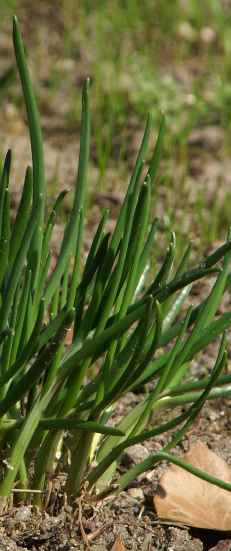
|
|
Young onion plants
|
Nearly every North Indian recipe starts with the same procedure: Spices are fried before the other ingredients enter the pot.
In its full incarnation, the procedure consist of three main steps: In the first step, the most heat-resistant spices are fried
at high temperature. This usually means cloves, cinnamon, black cardamom,
green cardamom, Indian bay-leaves in order of decreasing heat tolerance.
When cloves swell, cinnamon quills unroll, cardamom pods start to open and a strong aroma develops, temperature is quenched by
adding fresh spices: Onions, garlic and ginger. In this second step,
temperature will fall to somewhat above 100 degrees because of the water content of the fresh spices, and will slowly rise as
the water evaporates. In the third step, heat-sensitive spices are added: cumin, ajwain, asafetida,
mace and many more. Chiles may enter in any step, depending on whether they are dried, fresh or ground.
As a result, an oily, highly aromatic mass is obtained that is also sometimes referred to as baghar or simply
masala [मसाला]; in English, it is sometimes referred to
as wet masala, where wet implies oily
, not watery
. At that point, further ingredients according to the recipe are added,
either solids (vegetables, meat chunks) to fry or liquids (chopped tomatoes, yoghurt, coconut milk) to finalize the gravy.
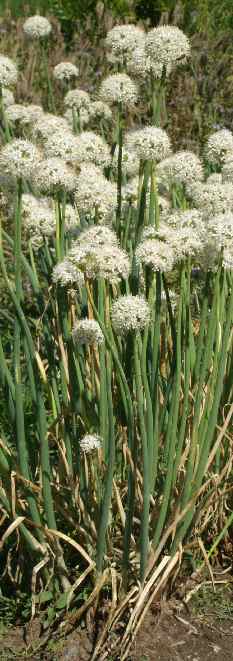
|
|
Flowering onion plants
|

|
|
Young onion plants
|
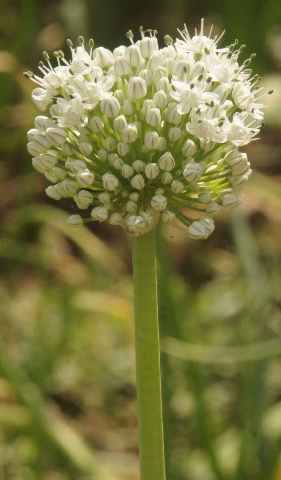
|
|
Onion flowers
|
All the rules of baghar may be violated, and this gives Indian cookery its flexibility. Onion-free
concoctions are perfectly feasable, but require good heat control or excellent timing for the temperature-sensitive spices.
Any ground spices should go very late, and particularly ground chiles need some experience for
they burn very easily; on the other side, they provide good flavour and excellent colour. In the South, onions quite often get
omitted, and if used are usually ground into a paste together with the other fresh spices; the latter method becomes increasingly common in the North,
and then the second and third step are often combined. Mustard seeds, commonly used in the South, need high temperature for
a short time, and should enter the pot shortly before the fresh spices; but they are more often dry-toasted in advance where
they are easier to control. Some simple baghars omit steps one and two, for example in Bengal where the
five spices
panch phoran [পাঁচ ফোড়ন]
(see nigella) all fall in category three; such a simple baghar resembles a
tarka (see ajwain), but it marks the beginning, not the end of the preparation.
Any Indian spice can enter a baghar, with the obvious exception of fresh herbs (coriander, mint);
but fresh curry leaves are commonly used in South India. They can be added at the end of step one as they tolerate a lot more heat than
one might expect. Entire coriander seeds are rather rare in baghar, but they show up more often in recipes that
employ a powdered mixture of spices. Ground seeds like almond or poppy can help to thicken the resulting gravy
and provide some nutty flavour. Black cumin appears to be never used.

|
|
Onion flowers
|
In the Imperial cuisine of Northern India (moghul cuisine, see
black cumin), gravies are prepared in a similar
way; yet aromatic spices (cinnamon, Indian bay-leaves, mace and cloves) are used more lavishly at the cost of pungent
chiles. Moreover, gravies are usually based on yoghurt, which is an
expensive option not so much embraced in everyday cooking.
Gravies based on onion are prepared in another way in Burma, whose unique
situation between China, India and Thailand has given rise to a unique cuisine.
The dishes called curries
in Burma are meat cubes or vegetables braised in a
rich spicy gravy prepared in advance: Onions, vinegar, garlic, fresh ginger, cumin, coriander and of
course chiles are blended to a smooth paste and
fried in sesame oil until the fat separates from
the gravy. By the long frying procedure, Burmese curries acquire a very
complex taste not easily found in the cuisines of other countries.
Pastes prepared by grinding onions together with a variety of spices are known
in quite many countries. Since raw onions easily turn bitter, such pastes must
be prepared fresh and used without much delay; alternatively, they can be
preserved by adding some acid (e. g., vinegar or lemon juice). Indonesia displays a great variety of
onion-based spice pastes (bumbu, see lemon grass); from the New World, Jamaican jerk
is the most famous example (see allspice). Both
concoctions are mostly used to marinate meat or fish.
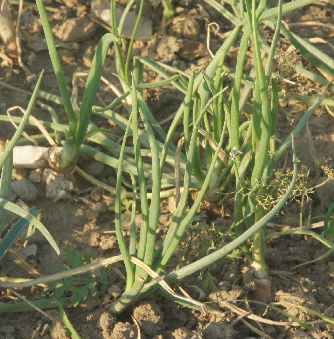
|
|
Onion plants in a garden
|
On frying, onion changes its taste and turns more sweet and aromatic; the
flavour develops best after long frying in comparatively cool fat (I prefer
clarified butter ghi [घी],
but this might be a personal preference). Fried onion
rings are popular in Central Europe as a decoration, e. g., for German
Kartoffelpüree (mashed potatoes), but they are
also known in Vietnam and especially in Indonesia, where
nasi goreng (fried rice, see galanga) is nearly always
topped with them. After removal of the fat used for frying, they can be stored
for several hours without losing their crisp texture, provided they are kept
in an air-tight container.
Boiled onions acquire a mild, sweetish flavour and can be used as a vegetable.
In some lightly-flavoured European foods, boiled onions contribute to the
overall flavour. For example, Central European versions of bouquet garni
often employ onions as flavourings for boiled stocks (German Suppengrün,
see parsley). Another example is the Yiddish specialty
gefilte fish, see white pepper.

|
|
Onion plants in a garden
|
An interesting combination of fried and boiled onions is the Chinese cooking technique
known as cong shao [蔥烧] onion-braising
:
It consists of frying shallots in oil, then adding stock and boiling foods in the resulting liquid.
See also cassia for a more detailled description of the related red braising technique.
Onions may also be dried, in which case they again change their flavour and
turn more garlic-like. Onion powder is a rather popular spice in the South of
the US and in México, and forms part of commercially available chile-con-carne spice mixtures (together with cumin, oregano, garlic, pepper and chiles). Dried onions are in important flavouring in
Eritrean cuisine (see long pepper).
Shallots stem from a closely related plant, Allium ascalonicum. They are
smaller and grow in clusters with up to five bulbs; their taste is somewhat
finer and less pungent. Shallots are most popular in Northern France, where
they are essential for sauces based on red wine. Contrasting the usage of
ordinary onion, shallots are never fried (because the French believe them to
turn bitter on frying), but mostly cooked or braised (e. g., for sauces made
from red wine). Shallots are called for by the classic recipe sauce béarnaise (see tarragon).
Quite many Far Eastern cookbooks suggest using shallots instead of onions,
since the latter are closer to Asian onions both with respect to size and
flavour. Shallots are particularly suited to substitute onions in the
Indonesian spice paste bumbu (see lemon grass).






